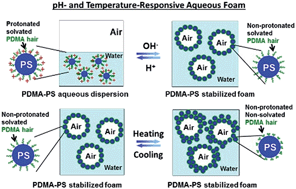pH- and temperature-responsive aqueous foams stabilized by hairy latex particles†
Abstract
Polystyrene (PS) particles carrying pH- and temperature-responsive poly[2-(dimethylamino)ethyl methacrylate] (PDMA) hairs (PDMA–PS particles) were synthesized by dispersion polymerization. The diameter, diameter distribution, morphology, chemical composition and surface chemistry of the particles were characterized using scanning electron microscopy (SEM), elemental microanalysis, dynamic light scattering and zeta potential measurements. The hydrophilicity–hydrophobicity balance of the PDMA could be tuned by varying both pH and temperature and therefore these sterically stabilized particles acted as doubly stimuli-responsive stabilizers for aqueous foams by adsorption and desorption to/from the air–water interface. At and above pH 6.0, in which range the PDMA hairs were either non-protonated or partially protonated, particle-stabilized foams were formed at both 23 and 55 °C. The foam prepared at 55 °C was the more stable of the two, lasting for at least 24 h, whereas the 23 °C foam destabilized within 24 h. SEM studies indicated that the particles adsorbed at the air–water interface as monolayers at 23 °C and as multilayers at 55 °C. At and below pH 5, in which range the hairs were cationic, hydrophilic and water-soluble, no foam was formed irrespective of temperature. Rapid defoaming could be induced by lowering the solution pH at both temperatures, due to rapid in situ protonation of the PDMA hairs, prompting the PDMA–PS particles to desorb from the air–water interface. The foaming and defoaming cycles could be repeated at least five times.


 Please wait while we load your content...
Please wait while we load your content...